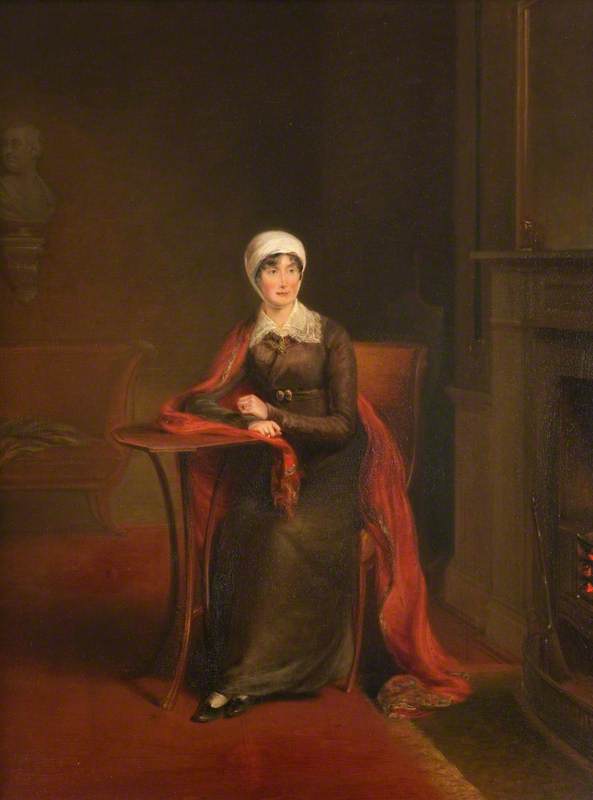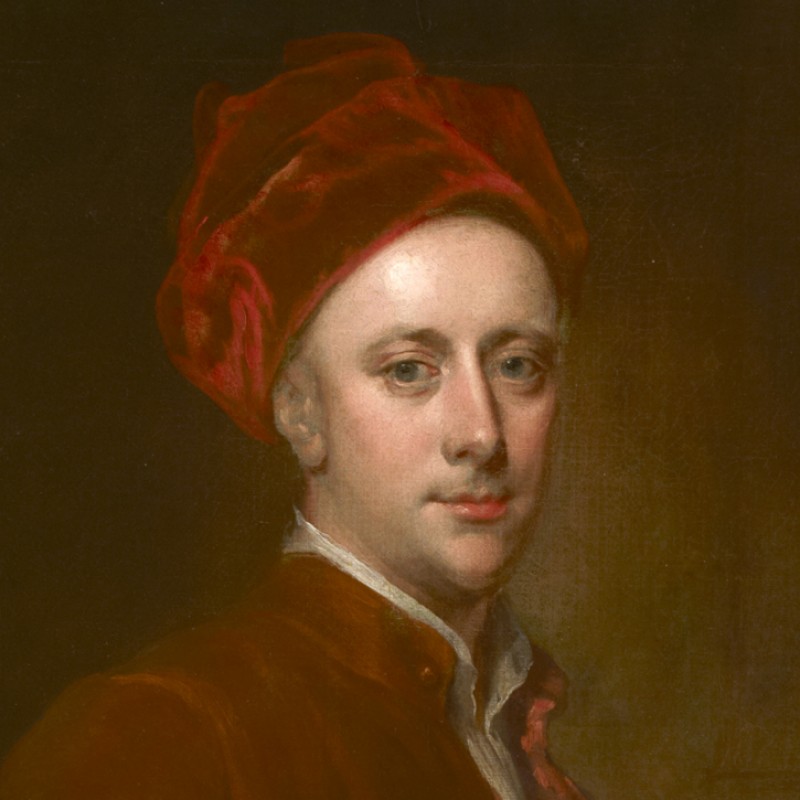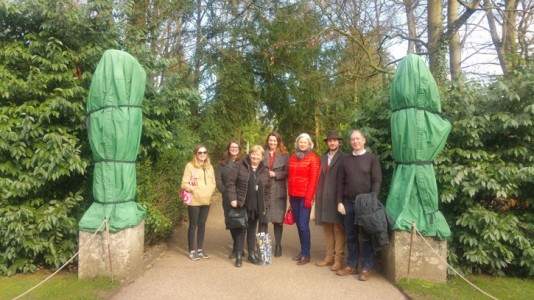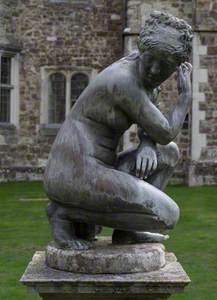To celebrate the launch of National Trust sculpture on Art UK, Alice Rylance-Watson, Collections Cataloguer at the National Trust, shares six sculptures at Knole to look out for on your next visit.
Venus and the gladiator, Green Court

Image credit: National Trust Images
John van Nost the elder (c.1655–c.1712) (possibly) and Richard Osgood (active 1691–1728) (possibly)
National Trust, Knole

Image credit: National Trust Images
John van Nost the elder (c.1655–c.1712) (possibly) and Richard Osgood (active 1691–1728) (possibly)
National Trust, KnoleMounting sculpture outside was a way for aristocrats to display their wealth, taste and learning beyond the private realms of their home. The first sculptural status symbols to greet any visitor to Knole are these statues mounted in the Green Court cast in lead after two of the world's most famous antiquities: the Crouching Venus and the Borghese Gladiator.
Although several antique versions of the Crouching Venus are known, the Knole cast is closest to the second-century AD marble version in the Royal Collection (but on display in the British Museum). The Royal Collection version was bought by Charles I in 1631 and then by the painter Sir Peter Lely after the king's execution. Around the same time as acquiring Venus, Charles I also made the Borghese Gladiator an overnight success by commissioning Hubert Le Sueur to cast it in bronze. Soon copies started appearing in stately homes across the nation.
According to a receipt dated 6th September 1697, the sculptor Richard Osgood was responsible for 'the case for the Venus and pedestal' and 'For the Gladiator as agreed'. Osgood's workshop at London's Hyde Park Corner was situated within spitting distance of the workshop of Britain's leading sculptor in lead John Nost, so it is likely that the casts were a collaborative effort, as Nost went on to carve a near identical Venus in marble five years later. Osgood personalised the Knole Gladiator with a lead shield ornamented with the Sackville coat of arms, an embellishment of the original from antiquity which has no armour.
Perseus triumphant, Orangery
Walk into the Orangery and you will be met by a monumental plaster cast of Perseus holding the severed head of Medusa. Unlike Benvenuto Cellini's grisly, even grotesque version in the Loggia dei Lanzi, Florence, this cast after Canova's marble statue saves us all the gory details. With sedate grandeur, a proportionally ideal Perseus lifts Medusa's head as if it were effortlessly cantilevered in space: a mark of Canova's technical excellence. In line with neoclassical principles, the sculptor deliberately modelled his subjects on classical archetypes: Perseus on the Apollo Belvedere and the Gorgon on the Medusa Rondanini, a Roman marble after a lost Greek bronze which was the first sculpture to show Medusa as a classically beautiful woman, albeit with a stare that could turn you to stone.
A lute-playing centaur, Stone Court
In the Stone Court, a rare English alabaster depicts the mythical but menacing ichthyocentaur. Half-man, half-sea monster, but with the razor-sharp talons of an eagle, this marine god is playing the lute, his song having mesmerised a female victim constricted in his serpentine tail.
The alabaster was carved in England from an engraved cartouche design by Jakob Floris published in Antwerp in 1564. Floris' printed designs first emerged in England in maps from 1576, but a few years later they appeared in sculptural plasterwork and chimneypieces in three known country houses in Wiltshire and Devon. None of the strapwork which usually frames a cartouche design was included in the Knole panel, so it is a rather anomalous yet fascinating example of how a print exported from Antwerp was translated into a sculpture by an English early seventeenth-century alabasterman.
Et tu, Brute? Stone Court
You could be forgiven for thinking that this colossal marble bust in the Stone Court depicts a member of the gladiatorial ring rather than the senate, yet it allegedly shows Brutus, the politician who famously deposed Julius Caesar in a murderous coup. The bust was bought by John Frederick Sackville, 3rd Duke of Dorset, on his Grand Tour of Italy, and was sourced by the infamous dealer and cicerone Thomas Jenkins on the understanding that it was a classical antiquity. Jenkins charged Sackville £40 for it, around £3,500 in today's money.
It was only in 1882, when Adolf Michaelis conducted his survey of classical sculpture in Great Britain, that doubts about its provenance arose. Michaelis wrote that 'the entire specimen is more than suspicious', a hunch investigated over 70 years later by Cornelius Vermeule who confirmed that the bust was in fact 'Renaissance' and in the same hand as another reputedly 'classical' bust at Knole. Vermeule believed it to be an imitation of a third-century AD bust of the Roman emperor Philip the Arab.
La Baccelli: His Grace's mistress, Great Staircase

Image credit: National Trust Images
Giovanna Francesca Antonia Giuseppe Zanerini (1753–1801), Called 'La Baccelli' 1778
Giovanni Battista Locatelli (1734–1805) (attributed to)
National Trust, KnoleThe 3rd Duke of Dorset was a notorious womaniser. This sculpture, which can be found at the bottom of the Great Staircase, depicts his favourite mistress, the Italian ballerina Giovanna Baccelli. It is attributed to Giovanni Battista Locatelli and was cast in plaster in 1778. Baccelli is nude and lies seductively on a divan propped up by pillows in the stance of Bernini's Sleeping Hermaphroditus. Account books and exhibition lists at the time title the sculpture 'Venus, reclined on a couch' for the sake of decorum, though it was no secret that it portrayed Baccelli and that she and the Duke were lovers.
The sculpture was the first of a number of portraits Sackville commissioned of his mistress throughout their ten-year relationship, the most famous being a painting by Thomas Gainsborough showing Baccelli dancing in a white and blue-trim silk dress. The couple had a son and lived together at Knole until Sackville married the heiress Arabella Cope in 1790 and Locatelli's sculpture was moved to a more discreet location in the house.
Sculpture in the National Trust encompasses thousands of years of making, by artists around the world, in an array of different media. Art UK will be publishing over 2,000 sculptures from National Trust properties in the coming months, each sculpture accompanied by updated catalogue entries showcasing fresh research and new discoveries.
Alice Rylance-Watson, Collections Cataloguer (Sculpture) at the National Trust



































